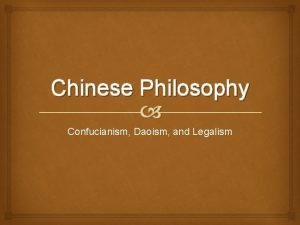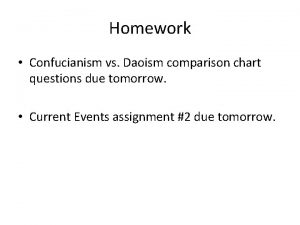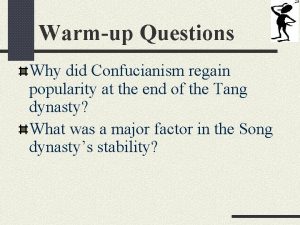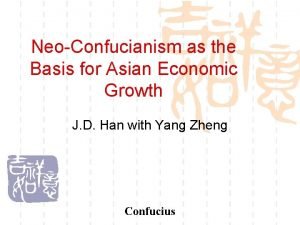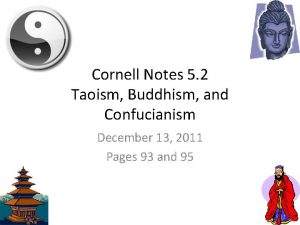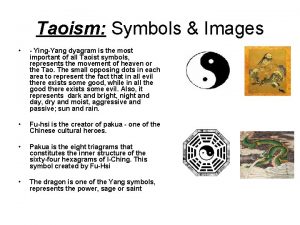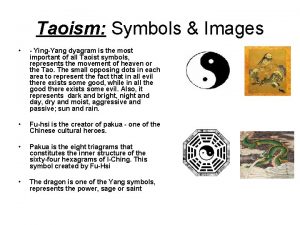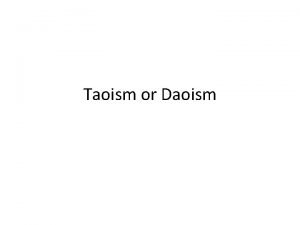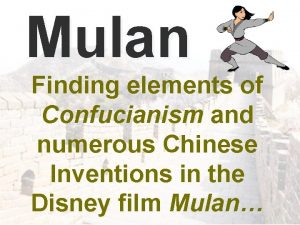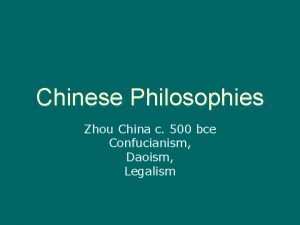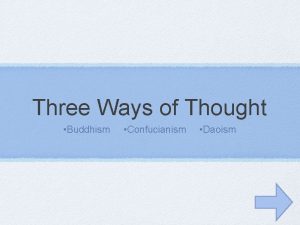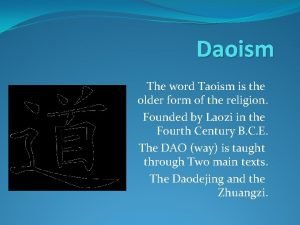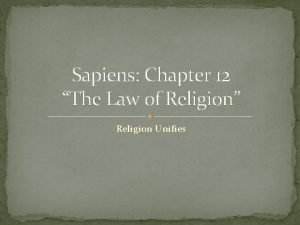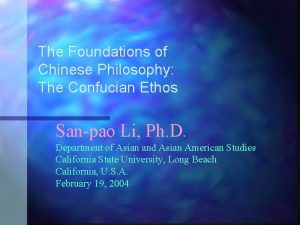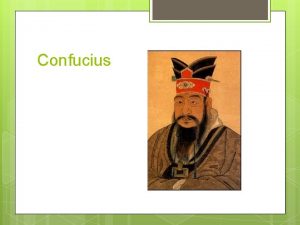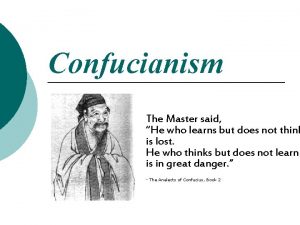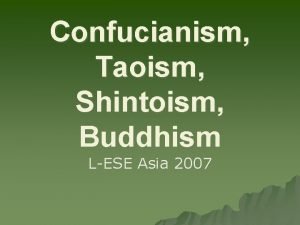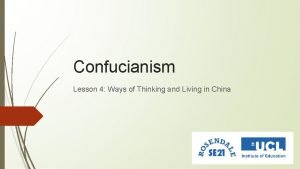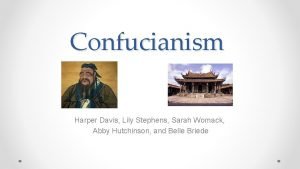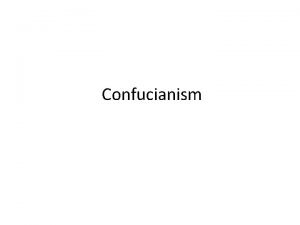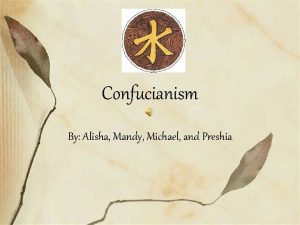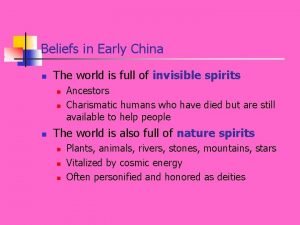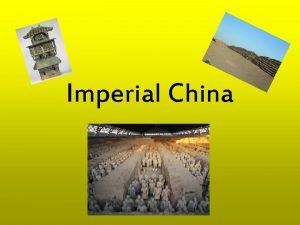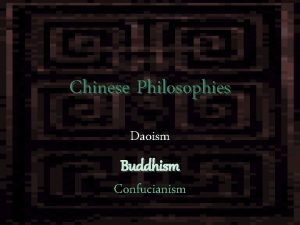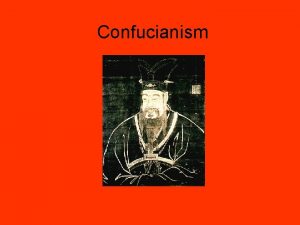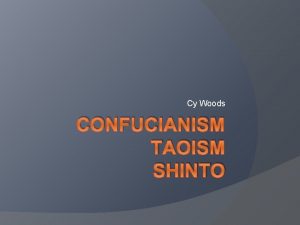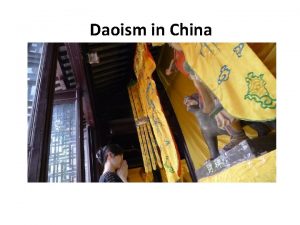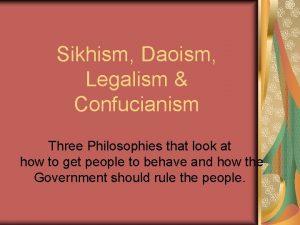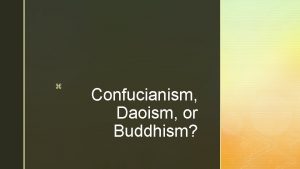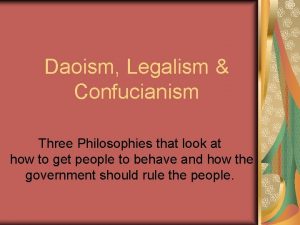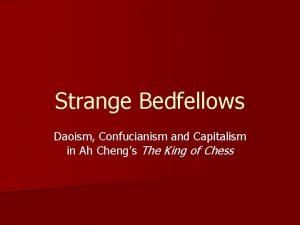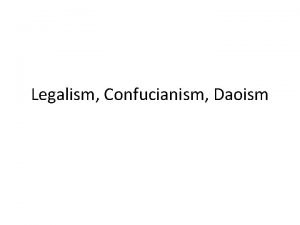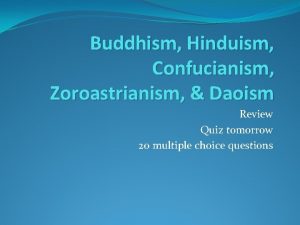COMPARATIVE PERSPECTIVES ON FUNDAMENTAL HUMAN SOCIALITY CONFUCIANISM DAOISM











































- Slides: 43

COMPARATIVE PERSPECTIVES ON FUNDAMENTAL HUMAN SOCIALITY CONFUCIANISM, DAOISM AND CONTEMPORARY SCIENCE OCT 7 TH RENMIN UNIVERSITY OF CHINA SCHOOL OF PHILOSOPHY

A. INTRODUCTION (1)

HISTORY EAST AND WEST (1) PRE-MODERN EARLY MODERN post-modern

SCIENCE IN THE WEST: MATTER (1) A body is necessarily: ‘circumscribed, limited and particular’ ‘matter cannot change’ Ulrich Zwingli, 1528

SCIENCE IN THE WEST: WORLD (1)

SCIENTIFIC ENLIGHTENMENT (1) SIR ISAAC NEWTON FOUCAULT HOMO FABER TECHNOLOGICAL REASONING SCIENTIFIC REASONING HEGEL KANT HABERMAS

SECOND ENLIGHTENMENT? (1) EVOLUTIONARY ANTHROPOLOGY ALTRUISM HOMO SOCIUS so c ial NEUROSCIENCE OF SOCIAL COGNITION MIRROR NEURONS NICHE CONSTRUCTION rea so nin g

The Team KAI VOGELEY GARY BENTE ADAM ZEMAN OLIVER DAVIES AGUSTIN FUENTES

B. METHODOLOGY (2 -4)

The Methodological Challenge (2) • 1 a. Science delivers authoritative knowledge but not the meanings by which we live (scientism is the failure to understand this). • 1 b. Scientific knowledge is highly specialized and diverse. • 2 a. For the human person however integration is fundamental. • 2 b. We live by short term and long term meanings: social, implicit or explicit, practice and context-based, narrativist, pragmatic, creative. • 3 a. Science is ‘objective’ (i. e. ‘causal’), while the person is ‘subjective’ (i. e. ‘free’). These have produced different kinds of philosophy in the past. • 3 b. How then can we now learn from the science of human sociality what it is to be human?

Three Resources (3) 1 a. There are three principal resources for understanding the human in depth, as both social and technological, from a scientific perspective. The first is evolutionary anthropology. This is focused on the ‘past’. It is ‘time-based’ and concerned with our ‘becoming’. It studies both our sociality and our tooluse. It accesses the archaeological record and engages with periods prior to the emergence of advanced modern language. This is functional analysis at the micro-level.

Three Resources (3) 1 b. The second is the neuroscience of social cognition. This is concerned with our ‘present’ and with what we are today. This science is concerned with the ‘deep’, ‘participative’ and interactive communication and bonding of our bodies at speeds beyond the awareness of consciousness. It focuses on the pre-linguistic ‘anatomical space’ of the human social cognition system in the living human brain. It too is functional analysis at the micro-level.

Three Resources (3) 2. The third resource are living, ‘deep’, long term communities in our own modern world. These are carriers of long-term meanings. It is reasonable to assume that such long term meanings must grounded in the structure of the human body as a constant across space and time. They must be in some kind of relation with our ‘deep’ biology. For example, Confucianism and Catholicism may potentially offer data for a functional analysis of human sociality, at the macro-level. They will reflect both our prelinguistic embodiment and the advanced linguistic self, as these combine in us as modern human beings.

Three Resources: Questions (3) 3 a. Do evolutionary anthropology and neuroscience of social cognition overlap in their ’seeing’ of the human? 3 b. Can science help us identify a fundamental structure within the pre-linguistic/linguistic divide of our human embodiment? What implications are there for philosophy? 3 c. How is the combination of homo socius and homo faber in ancient human beings changed by the emergence of advanced modern language and the advanced linguistic consciousness that it supports?

The Creative Overlap (4) 1. Evolutionary anthropology shows that our power of bonding is ancient: systemic altruism is present in our genus from 1. 8 million years ago. (Spikins et al. 2010). 2. Neuroscience of the social cognition system (by which we bond) involves processes that recognize human movements and high density information exchange through motor reflexes. These are ‘ancient’ areas of the brain (Vogeley 2016).

The Social Cognition System ‘PARTICIPATIVE SENSE MAKING’ ‘IN THE WORLD AND OF THE WORLD ’ ‘SELF-ORGANIZING’

The Creative Overlap (4) 3. Evolutionary anthropology: advanced language and advanced linguistic consciousness are very late. Sporadically present perhaps from 60, 000 yrs ago and systemically present from 12, 000 years ago (first full representations of the human face and first massacre from 10, 000 yrs ago). The late emergence of advanced language was governed by cultural and environmental factors rather than by biology or genetics.

The Creative Overlap (4) 10, 000 years ago FACE HAND language

The Creative Overlap (4) 4. Neuroscience and language: the recently discovered ‘semantic system’ is in the neocortex, which is the most ‘recent’ area of the brain (A. Huth et al. 2016). The meanings of even the most sophisticated words are located physically in the three-dimensional voxels of the neocortex. Even advanced mathematics entails the materiality of the sign. Language is the product of the creativity of both homo socius and homo faber.

The Creative Overlap: Conclusions (4) 5. There are two separate systems in play in the human body: the early, pre-linguistic altruistic system and the late developing, self-aware, advanced language system which supports advanced linguistic consciousness. 6. Since both entail different kinds of reasoning, within the single human body, we can say that there is a potentially highly creative unity between homo socius (‘social reasoning within complexity’) and homo faber (‘objectifying reasoning reducing complexity’) but also a potential for deep tension.

C. HISTORY (5 -7)

Unity and Tension in the Human (5) 1. Homo socius: Reasoning: participative; open; noncontrolling; non-objectifying; non-instrumentalizing: This is person to person reasoning of the FACE (sharing) which accepts complexity 2. Homo faber: Reasoning: observer; controlling; objectifying; instrumentalizing: This is person to world reasoning of the HAND (working) which reduces complexity

What makes us Human? (6) 1. For three million years we have shown signs of being both social and technological. 2. Our sociality and our technology are both creative (seeing the person in the movements of the face; seeing the tool in the stone). 3. Human evolution has been guided by the close and intense interaction of Homo socius and Homo faber: the so-called ‘ratcheting effect’. Tool manufacture was always learned in groups and so was intensely social.

What makes us Human? (6) 4. The balance between Homo socius and Homo faber was controlled by culture and environment. In times of socius, we were more static, In times of faber (contact with new technologies and groups), we were more innovative. 5 a. Our advanced modern language, with its origins in both ‘face’ and ‘hand’, is the creative realization of this dual creativity. The brain thinks modern words are ‘tools’ (and they appear following the development of sophisticated Levallois and Mousterian tool-making techniques).

What makes us Human? (6) 5 b. The learning of a language is the internalization of material signs, of sound or shape, which are held in common across a linguistic community. This points to a common material change in the brains of members of that community, which grounds the possibility of an enhanced sociality. 5 c. The external emphasis and performance of the internal materiality of the sign as shared intensifies human solidarity and sociality within the group. It ‘disarms’ language. We laugh together and tell each other stories in close relationships. In public rituals there is rhythm, chant, calligraphy and singing.

The Neolithic Challenge (7) 1 a. Prior to the Neolithic (c. 10, 000 years ago), we lived in the main in peaceful hunter gatherer groups of several hundreds or less. 1 b. With the Neolithic came agriculture, settlement and walled townships, and a significant, sudden increase of population size to 3000 -4, 000. 1 c. The ‘Dunbar number’ suggests that we can only sustain face-to-face relationships with up to 150 people.

The Neolithic Challenge (7) 1 d. With the arrival also of advanced language, the first systemic massacre of a community of human beings by another occurs in the early Neolithic some 10, 000 years ago. Words and tools have become weapons in the hand that are turned against the human face. There is no evidence of systemic intra- or interhuman violence before the Neolithic. 2 a. We are the sole human lineage to survive into the modern period (of 20 or so). How did we survive the Neolithic with its significant destabilization? How did the human social cognition system adapt to larger populations.

The Neolithic Challenge (7) 2 b. What can we lessons can we learn from this early adaptation for today, when we are once again experiencing ‘population growth’, or the compression of space and time, through processes of globalization? (Cf. Marx in ‘Results of the direct production process’, 1864, publ. 1933). 2 c. Can we re-discover the fundamental unity of technology and sociality in genus Homo? What practices might reveal this? What new practices might follow from this breakthrough in selfunderstanding?

D. THE HUMAN SOCIAL COGNITION SYSTEM (8 -9)

The Social Cognition System ‘PARTICIPATIVE SENSE MAKING’ ‘IN THE WORLD AND OF THE WORLD ’ ‘SELF-ORGANIZING’

The Extended Social Cognition System FACE TO FACE: DEEP HARMONY CULTURE: EXTENDED HARMONY

The Adaptive Social Cognition System (8) 1 a. Modern advanced language is the creation of the creativity of both face and hand, in combination. 1 b. Modern advanced language can embody either a) the face and its sharing social and participant reasoning or b) the hand its working and ordering reasoning of the observer. 1 c. The human social cognition system is an internal and biological system, composed of harmonic rhythms and interactive responses at speeds imperceptible to consciousness.

The Adaptive Social Cognition System (8) 2 a. History suggests that in the Neolithic this internal and biological system pressed through advanced language and realized itself externally and culturally in the social spaces between people. 2 b. The human social cognition system adapted to larger numbers by externalizing itself in culture through performance. 2 c. This constituted an enhancement of homo socius to counterbalance an enhanced homo faber.

The Cultural Performance of the Social Cognition System (9) Religion and Values 1 a. RITUAL: rhythm, harmony, movement in social spaces (禮 Lĭ) 1 b. ETHICAL IMPERATIVES: Golden Rule, ’social reasoning’, compassionate reasoning (義 Yì) 1 c. LOVE: reason and emotion combine in compassion (仁 Rén, 心 Xīn) 1 d. HEAVEN: externalization of social cognition system as world, grounds cosmologies of human ultimacy (天 Tiān)

The Cultural Performance of the Social Cognition System (9) Civilization 2 a. RECIPROCITY: Mutual obligations (德 Dé) 2 b. ARTS: (六藝 liù yì) calligraphy, music, mathematics … 2 c. ALL UNDER HEAVEN: global identity, borderless societies (天下 Tiān-xià) 2. d. CULTURE: transformation of the patterns of nature (文 wén); manifestation of human potency (三才, sān cái) BUREAUCRACY: delegated authority: ‘systemization, customization, routinization’ (Ge Zhaoguang, 2017)

The Cultural Performance of the Social Cognition System (9) Self 3 a. Agency arguably lies with the social cognition system which is a highly adaptive system that has secured our long term survival 3 b. Advanced linguistic consciousness is arguably called by its very nature as integrative system (‘global workspace’) to further integrate with the powerful harmonic structure of the human social cognition system

The Cultural Performance of the Social Cognition System (9) Self 3 c. Such integration occurs where advanced linguistic consciousness freely assents to the body’s social reasoning in interfacial or social contexts 3 d. This is for advanced linguistic consciousness, which is designed to reduce complexity, to learn to tolerate the acceptance of complexity in the human other

The Social Cognition System ‘PARTICIPATIVE SENSE MAKING’ ‘IN THE WORLD AND OF THE WORLD ’ ‘SELF-ORGANIZING’

E. QUESTIONS FOR THE FUTURE (10)

Re-Balancing Face and Hand (10) 1. Newtonianism effected a substantial cultural enhancement of homo faber, to the virtual exclusion of homo socius, in Western modernity. But contemporary science now offers an enhancement of homo socius which can rebalance faber and socius. Western culture is resistant to homo socius however. Can we say then that China is the natural home (‘the host culture’) which can bring about the recalibration of genus Homo?

Re-Balancing Face and Hand (10) 2. Can China integrate the new science with its long term traditions and long term meanings in ways that will allow the greater recognition of a continuity between the two? Could this lead to practical adaptations in the use and development of new technologies in China which can produce a greater social viability and sustainability across the globe?

Re-Balancing Face and Hand (10) 3. Paul Ricoeur called for a comparable understanding of our human materiality (our social embodiment) to match the understanding we have of the materiality of the world which gives us technologies. While affirming the priority of its power in life and society, Ricoeur denied that philosophy can begin in the human face to face. Since it contains no possibility of objectification, it cannot be the point of departure for a critical philosophical analysis of the human (Ricoeur, 1974).

Re-Balancing Face and Hand (10) But as the continuity and discontinuity of reasoning between faber and socius comes into view, science now sees an objective structure in the face to face. This is a fundamental structure within the human, as evolved. It is the ‘overlap’ between evolutionary anthropology and neuroscience of social cognition that grounds its visibility. And so what kinds of philosophy might this produce? Would they reflect only Chinese ideas and traditions? Or could a new kind of Chinese-Western dialogue begin, combining philosophical resources from East and West in this re-articulation of the human as social?
 Confucianism daoism and legalism
Confucianism daoism and legalism Chinese philosophies comparison chart
Chinese philosophies comparison chart What were the main social classes of early china
What were the main social classes of early china Neo confucianism vs confucianism
Neo confucianism vs confucianism 杜維明
杜維明 Neo confucianism vs confucianism
Neo confucianism vs confucianism Confucian values
Confucian values Daoism founder
Daoism founder Taoist symbols and images
Taoist symbols and images Symbols taoism
Symbols taoism Taosim
Taosim Examples of daoism in mulan
Examples of daoism in mulan Sacred scripture of daoism
Sacred scripture of daoism Daoism sayings
Daoism sayings Principles of tao
Principles of tao Daoism/taoism definition
Daoism/taoism definition What was the impact of daoism in ancient china
What was the impact of daoism in ancient china Taoism beliefs
Taoism beliefs Daoism
Daoism Map of daoism
Map of daoism Is daoism monotheistic or polytheistic
Is daoism monotheistic or polytheistic Daoism beleifs
Daoism beleifs Daoism symbol
Daoism symbol Basics of daoism
Basics of daoism Taoism characteristics
Taoism characteristics Confucian values
Confucian values Religion
Religion Confucianism
Confucianism Monotheism chart judaism christianity islam
Monotheism chart judaism christianity islam Confucius beliefs
Confucius beliefs What is a sage in confucianism
What is a sage in confucianism When did confucianism begin
When did confucianism begin Where was confucius born
Where was confucius born Confucianism core beliefs
Confucianism core beliefs Confucianism beliefs
Confucianism beliefs Confucian values
Confucian values Similarities between taoism and confucianism
Similarities between taoism and confucianism Confucianismfounder
Confucianismfounder Confucianism facts
Confucianism facts Confucious facts
Confucious facts Confucianism bible
Confucianism bible Confucianism beliefs
Confucianism beliefs Confucianism beliefs
Confucianism beliefs Where did shintoism originate
Where did shintoism originate
